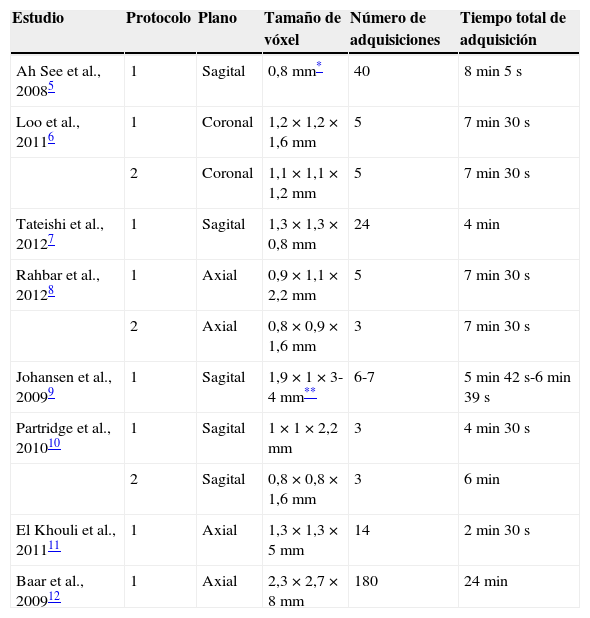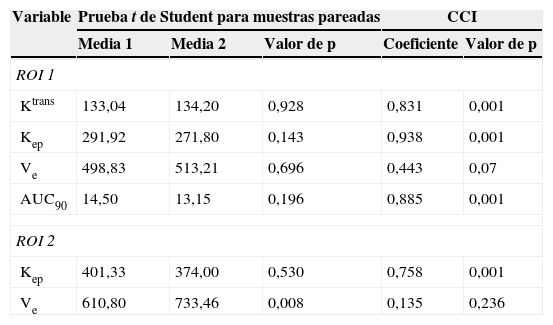Evaluar la reproducibilidad de un protocolo de resonancia magnética dinámica (RM-DC) con contraste para el estudio farmacocinético de los tumores de mama.
Material y métodosEstudio prospectivo realizado entre octubre y diciembre de 2009, que incluyó 12 pacientes con cáncer de mama infiltrante en estadios ii-iii sin tratamiento previo. Este trabajo fue aprobado por el Comité de Ética de Investigación de nuestro centro. A las 12 pacientes se les realizó 2 RM-DC en 2 días consecutivos con un protocolo de alta resolución temporal (21 adquisiciones/minuto). Se analizaron por separado los datos obtenidos en un ROI trazado alrededor del diámetro tumoral mayor (ROI 1) y otro que abarcaba la zona de mayor intensidad de Ktrans de la lesión (ROI 2). Se emplearon pruebas estadísticas paramétricas y no paramétricas para estudiar la reproducibilidad y concordancia de las principales variables farmacocinéticas (Ktrans, Kep, Ve y AUC90).
ResultadosLas correlaciones fueron muy altas (r>0,80; p<0,01) en todas las variables del ROI 1, y altas (r=0,70-0,80; p<0,01) en todas las del ROI 2, excepto en Ve tanto en el ROI 1 (r=0,44; p=0,07) como en el ROI 2 (r=0,13; p=0,235). No hubo diferencias estadísticamente significativas entre los 2 estudios para los valores obtenidos de Ktrans, Kep y AUC90 (p>0,05 para todas ellas), pero sí que las hubo para Ve en el ROI 2 (p=0,008).
ConclusiónEl protocolo de alta resolución temporal de RM-DC de nuestro centro es muy reproducible para las principales constantes farmacocinéticas de los tumores de mama.
To evaluate the reproducibility of a protocol for dynamic contrast-enhanced magnetic resonance imaging (DCE-MRI) for the pharmacokinetic study of breast tumors.
Material and methodsWe carried out this prospective study from October 2009 through December 2009. We studied 12 patients with stage ii-iii invasive breast cancer without prior treatment. Our center's research ethics committee approved the study. The 12 patients underwent on two consecutive days DCE-MRI with a high temporal resolution protocol (21 acquisitions/minute). The data obtained in an ROI traced around the largest diameter of the tumor (ROI 1) and in another ROI traced around the area of the lesion's highest Ktrans intensity (ROI 2) were analyzed separately. We used parametric and nonparametric statistical tests to study the reproducibility and concordance of the principal pharmacokinetic variables (Ktrans, Kep, Ve and AUC90).
ResultsThe correlations were very high (r>.80; P<.01) for all the variables for ROI 1 and high (r=.70-.80; P<.01) for all the variables for ROI 2, with the exception of Ve both in ROI 1 (r=.44; P=.07) and in ROI 2 (r=.13; P=.235). There were no statistically significant differences between the two studies in the values obtained for Ktrans, Kep and AUC90 (P>.05 for each), but there was a statistically significant difference between the two studies in the values obtained for Ve in ROI 2 (P=.008).
ConclusionsThe high temporal resolution protocol for DCE-MRI used at out center is very reproducible for the principal pharmacokinetic constants of breast.












